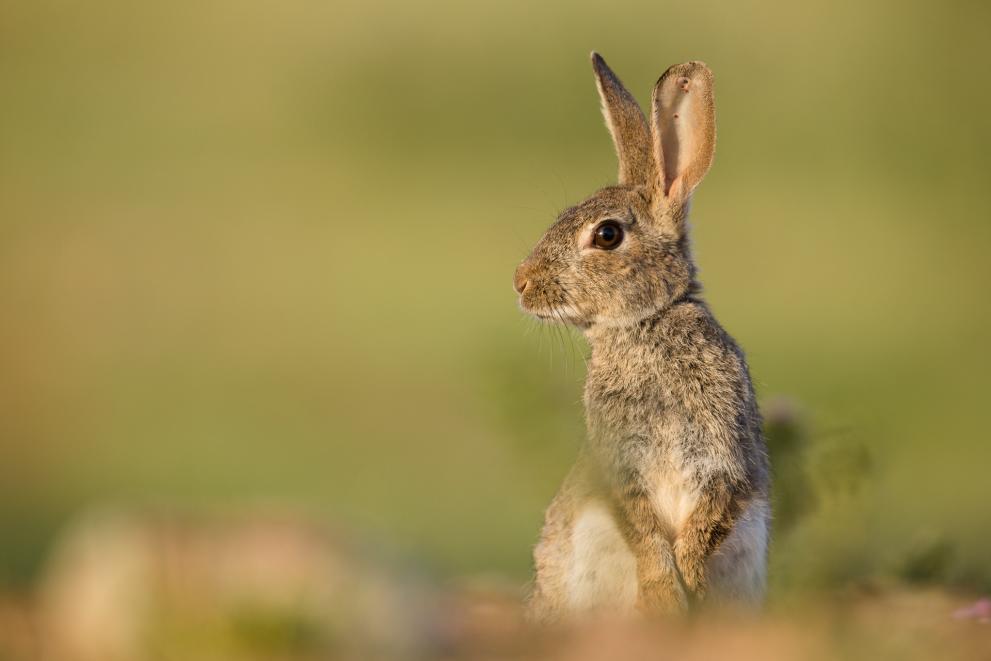
Rabbits are one of nature’s great survivors. Despite numerous setbacks - including devastating outbreaks of myxomatosis and other fatal diseases - rabbits continue to thrive in many European countries. Their ability to reproduce is legendary, and rabbits feature heavily in folklore from witchcraft to fertility rites. As far back as the ninth century BCE, Phoenician traders dubbed Spain the 'Land of Rabbits’.
It’s a very different story in today’s Iberian peninsula, however, where populations of the European Rabbit (Oryctolagus cuniculus) have plummeted by more than 90 percent in the past 70 years. That’s bad news not only for the rabbits themselves, but for the endangered predators which eat them such as the Iberian lynx and the Imperial eagle. Altogether, some 40 species are listed in the European Habitats and Birds Directives as depending on rabbits for food.
However, there’s a paradox: in some areas of Spain and Portugal, rabbit populations have risen dramatically, causing significant damage to fields and crops. According to LIFE Iberconejo, there were “occasional local demographic explosions that damaged crops or agricultural infrastructure, affecting almost 42,000 hectares/year on average”. That accounts for around half of all agricultural insurance claims.
Small wonder that farmers are wary of any attempt to protect the rabbits, despite the benefits for wildlife conservation. ‘The dual aspect of this rabbit - an endangered species [in the Iberian Peninsula] that also causes agricultural damage - greatly complicates its management,’ says LIFE Iberconejo project director Ramón Pérez de Ayala from WWF Spain, which coordinates the project.
‘That’s why it’s so important that everyone involved is united in the project and looking for common solutions. The reality is that without the solutions that LIFE Iberconejo is developing and implementing, it will not be possible to have effective management which allows us to maintain our ecosystems while reducing the associated social conflicts,’ adds Ramón. For this reason, the involvement of the Union of Small Farmers and Ranchers of Spain as partner is essential for the project success.
A key aim of the LIFE Iberconejo project - which runs until the end of this year -is to bring all sides together, including farmers and hunters’ groups. One of LIFE Iberconejo’s first actions was to set up the European Rabbit Iberian Coordination Committee (ERICC). This committee serves as a governance body, overseeing the management of rabbits across the Iberian Peninsula via protocols for monitoring their populations and health status, and damages to agriculture. ERICC comprises representatives from 16 groups, encompassing national and regional administrations, and stakeholders from hunting and farming sectors. Already the project has held an impressive 41 training sessions across 22 locations, attended by more than 500 people, and a recent conference on rabbit damage prevention attracted more than 200. A further 400 people have taken part in surveys, interviews and focus groups to ensure all views are heard.
Working with hunters is another key element for success - the Royal Spanish Hunting Federation (RFEC) is one of the project partners and they also sit on ERICC. Here again, a delicate balancing act is needed - over-hunting has been identified as one of the factors in the rabbits’ decline in some regions of Spain. A study carried out for the project by PreveCo points out that hunting “can be highly effective if properly carried out. However, it requires meticulous planning and execution at a number of different levels…It is crucial that the hunting pressure is applied at the appropriate sites in each hunting area.”
Balancing these conflicting needs and expectations is not easy. For the farmers, concerns about livelihoods must take priority. For the conservationists, it is vital to protect rabbits to help lynx and eagles. LIFE Iberconejo has already assessed 155 actions relating to the Common Agricultural Policy (CAP) which could help protect rabbits, whilst at the same time preventing damage by them. Project staff are also updating the catalogue of best practices for habitat management in Natura 2000 network Mediterranean forests and shrublands.
The project also works closely with LIFE LYNX CONNECT, another LIFE project currently running in Spain and Portugal which aims to increase lynx numbers by connecting isolated populations. Although still listed as ‘Endangered’ on the IUCN Red List, lynx populations are slowly recovering. Other collaborating projects such as LIFE PRIORITY AREAS, are also involved, with a specific focus on endangered species including the Imperial eagle.
‘Iberconejo will lay the foundations for the long-term management of the wild rabbit,’ says Ramón. ‘But we can’t pretend we can solve the complex problems that affect the species, nor expect a global recovery of its populations in the period covered by the project.’
As well as helping achieve the European Habitats and Birds Directives’s objectives, LIFE Iberconejo supports the EU Biodiversity Strategy for 2030, the Natura 2000 protected areas network, the European Green Deal, and the EU Climate Change Adaption Strategy.
Details
- Publication date
- 27 March 2024
- Author
- European Climate, Infrastructure and Environment Executive Agency

